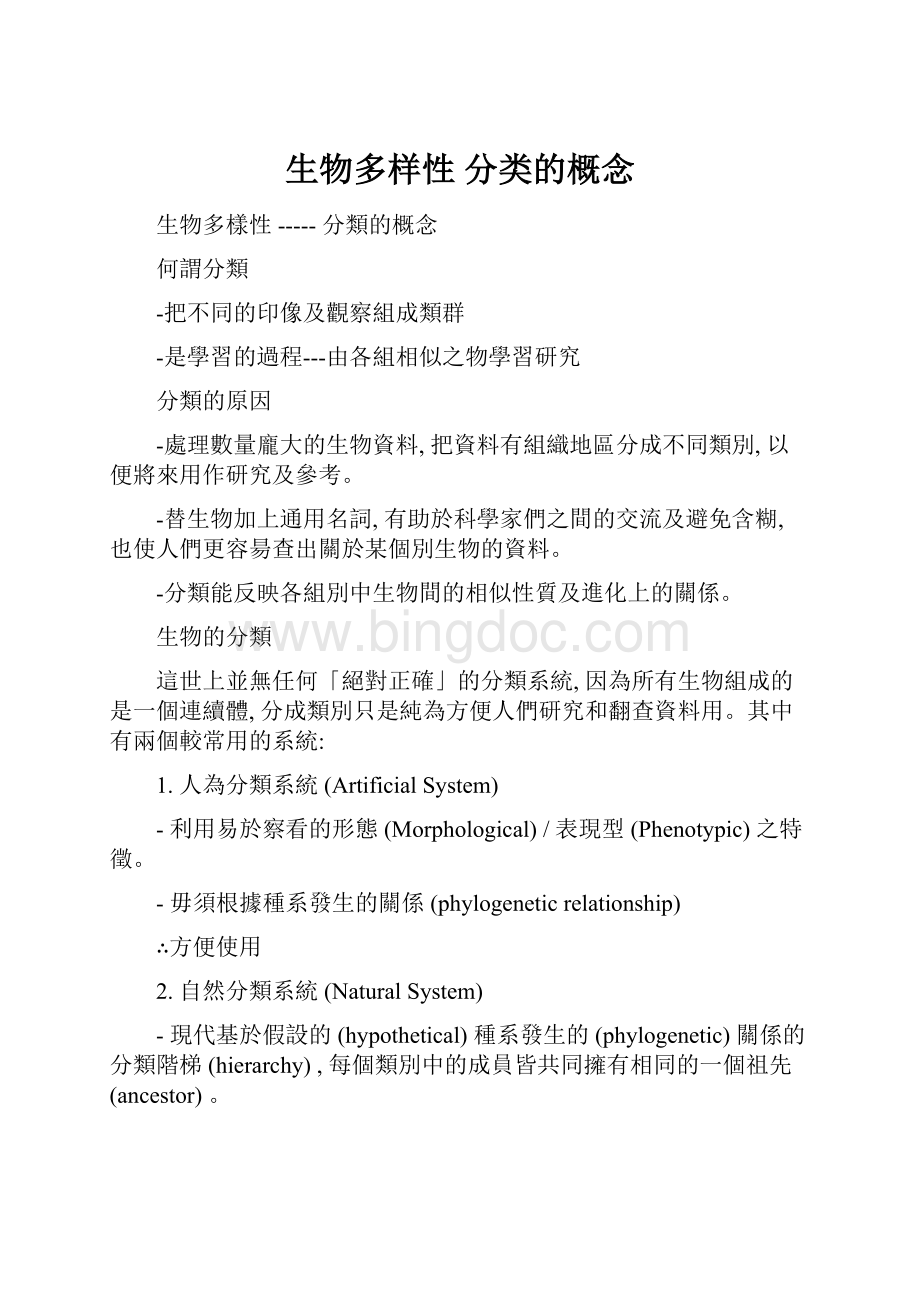生物多样性分类的概念.docx
《生物多样性分类的概念.docx》由会员分享,可在线阅读,更多相关《生物多样性分类的概念.docx(16页珍藏版)》请在冰点文库上搜索。

生物多样性分类的概念
生物多樣性-----分類的概念
何謂分類
-把不同的印像及觀察組成類群
-是學習的過程---由各組相似之物學習研究
分類的原因
-處理數量龐大的生物資料,把資料有組織地區分成不同類別,以便將來用作研究及參考。
-替生物加上通用名詞,有助於科學家們之間的交流及避免含糊,也使人們更容昜查出關於某個別生物的資料。
-分類能反映各組別中生物間的相似性質及進化上的關係。
生物的分類
這世上並無任何「絕對正確」的分類系統,因為所有生物組成的是一個連續體,分成類別只是純為方便人們研究和翻查資料用。
其中有兩個較常用的系統:
1.人為分類系統(ArtificialSystem)
-利用易於察看的形態(Morphological)/表現型(Phenotypic)之特徵。
-毋須根據種系發生的關係(phylogeneticrelationship)
∴方便使用
2.自然分類系統(NaturalSystem)
-現代基於假設的(hypothetical)種系發生的(phylogenetic)關係的分類階梯(hierarchy),每個類別中的成員皆共同擁有相同的一個祖先(ancestor)。
[假定的共同祖先的確定是基於同源的特徵(homologouscharacters),這些特徵在起源、結構以及部位上均有著根本的相似性質,不管它們在成體(adult)中起何種功能。
]
Theclassificationsystemissubjecttochangeasnewevidencesappears.
瑞典植物學家林奈(Linnaeus)1707-1778
-制訂了雙名系統的命名法(BinomialSystemofNomenclature)/雙名法(BinomialNomenclature)。
-每個生物的學名都有兩個拉丁文名部份,在文章中往往以斜體字印刷或在書寫字體下加上分隔的橫線予以區別:
例:
Man—Homosapiens/Homosapiens
第一部份是屬名(第一個字母常用大楷),第二部份為種名(全部字母以小楷寫)。
林奈的生物分類階梯:
界(Kingdom)
門(Phylum)
綱(Class)
目(Order)
科(Family)
屬(Genus)
種(Species)
界(Kingdom)
-起初,生物只被分類為植物及動物兩界
-隨著這些數量龐大又多樣化的生物在形態上、生物化學上及生理上有更多的特徵被發現,便需要有新的分類體制被採用。
五界(FiveKingdom)
-由生態學家RobertWhittaker建議
-是現代最受大部份生物學家接受的分類方法:
i.原核生物界(KingdomMonera)
ii.原生生物界(KingdomProtoctista)
iii.真菌界(KingdomFungi)
iv.植物界(KingdomPlantae)
v.動物界(KingdomAnimalia)
真菌界動物界植物界
原生生物界
原核生物界
-而五界的進化關係(Evolutionaryrelationship)如下:
種(Species)
-分類的最基本單。
-種內的生物擁有結構(structure),功能(function),及發展(development)上的相似性。
-種內的生物能互相交配生產可以生育之後代,而不能與別個種之生物於自然條件下交配繁殖出可生育之彼代。
屬(Genus)
-把各個相近的種組成一屬。
科(Family)
-把各個相近似的屬組成一科。
:
如此類推地建成分類的階梯。
[亞種(Subspecies)
-種是分類的基礎單位,但不是常用中最小的單位。
-壹些地理上分隔了的同種(samespecies)而不同生境(habitat)的不同種群(populations)常因隔離(isolation)而發展出某些貫的特徵把它們與同種中的其他種群有所區別。
若這些不同的種群互相交配,它們可產生有生育能力的下代,可見它們都是屬於同一個種的。
-我們稱呼這些擁有一貫而不同的特徵之各個種群為亞種(Subspecies)或變種/品種(Varieties)。
-至於一些細小的生物如細菌則稱為品系/菌株(strain)。
]
在分類學上有兩個較界更大的範疇
1.原核生物(Prokaryotes)
-缺少細胞核(nucleus),只有無核膜的核質散佈區域。
-脫氧核糖核酸DNA並非存在於染色體內,而是形成一環形DNA。
-細胞分裂時沒有紡綞體(Spindle)。
-鞭毛(flagellum)簡單(如果存在),缺乏微管(microtubules)。
-70S核糖體(較小,ribosome)。
-沒有被膜包圍的細胞器(membrane-boundedorganelles)。
例如:
內質網(Endoplasmicreticulum)
粒線體(Mitochondrion)
葉綠體(Chloroplast)
溶菌體(Lysosome)……等等
-沒有大液泡(vacuoles)。
-細胞壁(cellwall)由氨基酸和多糖組成(成份因種類而不同)。
-全屬於原核生物界(KingdomMonera)。
2.真核生物(Eukaryotes)
-有細胞核(由雙核膜包圍,內有核仁)。
-DNA與蛋白質(protein)組成染色體(chromosome)置於細胞核內。
-80S核糖體(80Sribosomes),較大,可散佈於細胞質(cytoplasm)中,或附於內質網上。
-被膜包圍的細胞器可能存在(單膜或雙膜)。
-包括其餘四個界中的生物。
-鞭毛有“9+2”排列的微管。
-其他特質請看’細胞’一課
3.其他
-例如:
病毒(virus)
--不屬於原核生物、真核生物或五界中任何一類。
生物
病毒(?
)原核生物真核生物
原核生物界原生生物界
真菌界
植物界
動物界
Virusesarenotincludedinthesystemsincethebodyorganizationiscompletelydifferentfromotherorganismsandtheiroriginandevolutionhadnotyetbeenclarified.
TheFiveKingdomSystemofgroupingorganisms
ThemostwidelyacceptedsysteminrecentyearsistheFiveKingdomSystem.
Thefive-kingdomclassificationincurrentuserecognisesthekingdomsProkaryotae,Protoctista,Fungi,Plantae,andAnimalia.Prokaryotesappearedabout3,500millionyearsagoandcompriseavarietyoforganismscollectivelyknownasbacteria.Eukaryotesincludeprotoctists,fungi,plantsandanimals.Theyappearedabout2,000millionyearsago,andprobablyevolvedfromprokaryotes.
PhylogeneticRelationshipsoftheFiveKingdoms
SixKingdomsofclassification-----Theclassificationsystemissubjecttochangeasnewevidencesappears:
Mostbiologistsacceptedthefive-kingdomclassificationsystemproposedbyWhittakeruntilthelater1980s,whenmolecularworkverifiedthepresenceoftwoverydifferentgroupsofbacteria.Asaresult,itwasproposedtoseparateProkaryotaintotwokingdoms:
Archaebacteria(theyareabletosurviveinextremeconditions:
halophiles–salty,methanogens–insewageandswampsedimentsandthermophiles–hotandacidic)andEubacteria(comprisesalltheotherbacteria).
Suchasystemissubjecttochangesinthefuture,asvirusesarenotyetassignedtoanyofthekingdom.
Dichotomouskey(二叉式檢索表)---基於外在/可觀察特徵
例:
建構一簡單二叉式檢索表以確認以下的生物類別:
1a細胞有細胞壁……………………………………………2
1b細胞沒有細胞壁…………………………………………3
2a有維管組織……………...………………………………Fern(蕨)
2b沒有維管組織………………………….…………………Algae(藻)
3a單細胞生物……………….………………………………Amoeba(變形蟲)
3b多細胞生物……………………………………………….Fish(魚)
Wayofusingthedichotomouskey:
1a2bAlgae(藻)
Exercises:
1.Toconstructadichotomouskeytoidentifythefollowingtypesoforganisms.
SuggestedSimpleDichotomousKeytotheAboveClassification
COLUMNA
COLUMNB
1a
Flowering
6
1b
Non-flowering
2
2a
Seed-bearing
Gymnosperm
2b
Seedless
3
3a
Plantbodydifferentiatedintostem,leavesorroots
4
3b
Plantbodynotdifferentiatedintostem,leavesorroots
5
4a
Havedistinct‘stem’and‘leaves’butnotrueroots
Moss
4b
Stem,leavesandtrueroots
Ferns
5a
Cellulosecellwall,chloroplastorotherphotosyntheticpigmentspresent
Algae
5b
Nocellulosecellwallandphotosyntheticpigment
Fungi
6a
Onecotyledon;floralpartsin3s;fibrousrootsystem;parallelleafvenation;stemusuallyherbaceousandslender
Monocotyledons
6b
Twocotyledons;floralpartsin4sor5s;taprootsystem;netleafvenation;stemhard,woodywithsecondarythickening
Dicotyledons
植物界KingdomPlantae:
Kingdom界:
植物
Divisions門:
苔蘚植物門真蕨門裸子植物被子植物門
Classes綱:
MoncotyledoneaeDicotyledoneae
單子葉植物雙子葉植物
植物界中各門之比較(ComparisonbetweendifferentDivisionsofPlants):
Division
門
Bryophyta(Mosses)
苔蘚植物門
Filicinophyta(Ferns)
真蕨門
Gymnosperm
裸子植物
Coniferophyta
松柏門
Angiospermophyta
被子植物門
細胞或組織的分化
分化成為簡單的’莖’,’葉’及’假根’,並有繁殖構造
有具纖管組織的根、莖和葉,細小成心形的原葉體
有具維管組織的根、莖和葉,並有毬果及裸露的種子用於繁殖
有具維管組織的根、莖和葉,並有花及藏於果實的種子用於繁殖
生境
潮濕陰暗及冷涼的地方
具有足夠的濕度於繁殖時期以利受精的地方(例如:
山邊的空曠地方)
不同的陸上生境,尤其於溫帶地區
不同的陸上及水生生境
例子
Funaria
葫蘆蘚
Dryopterisfilix
鱗毛蕨
Pinussylvestris
松
(任何正確答案)
ComparisonofClassMonocotyledoneaeandClassDicotyledoneae
Monocotyledoneae單子葉植物
Dicotyledoneae雙子葉植物
Embryohasonecotyledon胚胎一片子葉
Embryohastwocotyledons胚胎二片子葉
Narrowleafwithparallelvenation平行葉脈
Broadleafwithnet-likevenation網狀葉脈
adventitiousroots不定根
taproot主根,lateralroots側根
Scatteredvascularbundlesinstem莖部的維管束分散
Ringofvascularbundlesinstem莖部環狀排列的維管束
Flowerpartsusuallyinthrees花瓣等常是三的倍數
Flowerpartsusuallyinfoursorfives花瓣等常是四或五的倍數
e.g.Lilium---lily百合
e.gBellis---daisy雛菊
KingdomAnimalia:
Phylum
Cnidaria
Platyhelminthes
Annelida
Arthropoda
Mollusca
Echinodermata
Chordata
Symmetry
Radialsymmetry輻射對稱
Bilateralsymmetry兩側對稱
Bilateralsymmetry兩側對稱
Bilateralsymmetry兩側對稱
Bilateralsymmetry兩側對稱
Pentamerous(5-rayed)symmetry
Bilateralsymmetry兩側對稱
Support
somehavechitinousexoskeleton(Perisarc)inObelia
nil
-----------
Coelomicfluidactashydroskeleton
Chitinousexoskeletonwithjointedappendagesonbodysegments
Externaldorsalshell
Mesodermalcalcareousplatesbearingspinesasendoskeleton
Endoskeletonwithnotochordorbackbone
unique/specificcharacteristicsgenerallyfoundinthephylum
-Diploblastic,
non-segmentedacoelomate
-gut腸(enteron)withoneopeningasboththemouthandanus同一出口作為口部及肛門
-unique獨有Nematocysts(stingcells/cnidocytes)intentacles帶刺細胞的觸鬚fordefenceandcapturingfood
-polymorphism多形態現象shown:
sessilehydroid固著的螅體formandmobilemedusoidform移動的水母體
-flatdorsoventrally背腹地扁平
-unsegmentedworm
-beginningofcephalization開始有頭部的形成
-oneopeningserveasmouthandanus同一出口作為口部及肛門
-cylindricalmetamericallysegmentedbody身體有分節現象coveredbynon-chitinouscuticle被一層薄而濕潤的非幾丁質角質層覆蓋
-separatedopeningofmouthandanus口部與肛門之開口是分開
-cephalizationbutmaybenotdistinctinsomemembers
-mayhavechaetaeinsegments
-Coelomicfluidactashydroskeleton
-Chitinousexoskeletonwithjointedappendagesonbodysegments
-expandedhaemocoelasmainbodycavity
-bodybasicallydividedintohead,thoraxandabdomen(maybefused)
-mayhavecompoundeyes
-separatedmouthandanus
-Growthinstagesaftermoulting.
-Externaldorsalshell
-reducedcoelom,blood(withhaemocyanin)flowinhaemocoel
-softbodycoveredbyadorsalshell(calcareous)
-bodydividedintohead,visceralmass/visceralhump(coveredbymantleinsidemantlecavity)andmuscularfoot
-mosthaveradula(butabsentinbivalves)
-mostaquaticandhavegills
-separatedmouthandanus
-Mesodermalcalcareousplatesbearingspinesasendoskeleton
-withmouthandanusseparated
-unqiuewatervascularsystem
--water-filledcoelomictubes
--withextensionoftubefeet
--asexualregeneration
-Endoskeletonwithnotochordorbackbone
-presenceofnotochordinembryo
-notochordreplacedbyvertebralcolumninadultsofvertebrates
-asingle,dorsalandhollownervecord
-separatedmouthandanus
-gillslitsinembryo
Example(s)
Obelia藪枝螅
(ClassHydrozoa)
Jellyfish水母
coral珊瑚,seaanemone海葵
Planaria渦蟲
(ClassTurbellaria)
tapeworm絛虫
Earthworm/Lumbricus
(ClassOligochaeta)
SuperclassCrustacea:
Palaemon
(acommonprawn)
Mussel
(ClassBivalvia)
Starfish
(ClassStelleroidea)
fish,amphibian,reptile,birdandmammal
ClassInsecta:
Chorthippus
(agrasshopper)
Habitatoftheexample(s)
Marine海生/shallowcoastalwaters淺岸
Quietfreshwaterstream,pondsandunderstones恬靜淡水
insidehumanbody人體內
Moistterrestrialsoilhabitats/dampearth
Freshwater/marine
Marine
Marine
Terrestrial(e.g.grassland)
4.2.9Classificationofarthropods
CLASSIFICATIONOFVERTEBRATES
[生物學探究